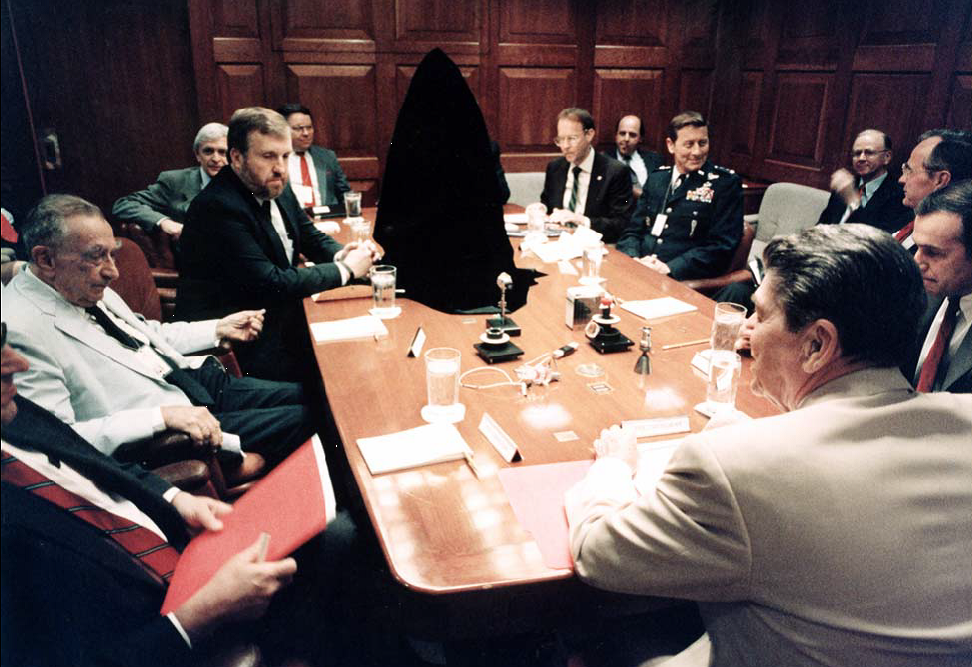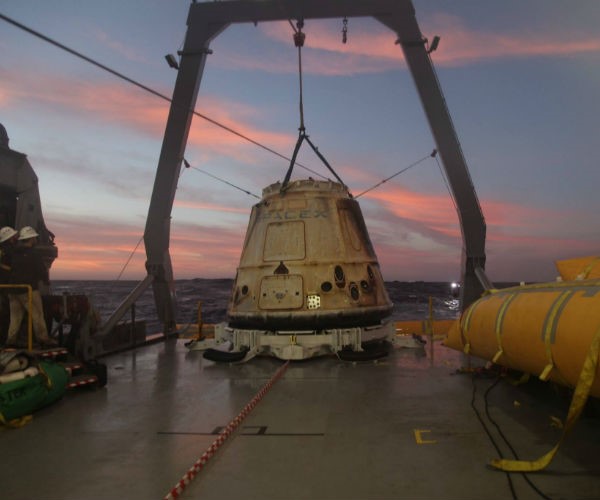SpaceX and others in the private sector are exploiting current technology that can enable a truly advanced space-based defense program — an advanced Brilliant Pebbles system that was the most important Ballistic Missile Defense (BMD) concept from President Ronald Reagan’s Strategic Defense Initiative (SDI). It entered a fully approved Concept Development and Validation (DemVal) program in 1990, anticipated to cost $20 billion (in today’s dollars), which could lead to deployment in space within five years and operate for 20 years. Current “powers that be” should follow the lead of SpaceX and others to build ASAP such advanced systems as part of President Trump’s Space Force.
I have repeatedly written about the private sector’s important role during the SDI era (1983-93) in developing truly cost-effective space-based BMD systems. Click here for my January 22, 2019 review that includes links to many prior messages. Regrettably, these efforts were cancelled by the Clinton administration in early 1993 and have since remained dormant. Finally, there is an opportunity for their revival — again with a potentially vital role played by the private sector.
The Prelude:
Those early efforts were pioneered by scientists and engineers at Lawrence Livermore National Laboratories (LLNL) and supported by the first SDI Director USAF Lt. General James A. Abrahamson. Especially the “Brilliant Pebbles” space based interceptor (SBI) concept was the very first SDI product approved by the Pentagon’s tip acquisition official to enter a Demonstration and Validation (DemVal) program, under the second SDI Director USAF Lt. General George Monahan.
Notably, General Monahan established a Brilliant Pebbles Task Force, reporting directly to him, to manage this important effort that exploited technology from the private sector as recommended by LLNL scientists and engineers, rather than the approaches then being followed by the Air Force.
I was privileged to continue that innovative and maturing technology demonstration program as the third SDI Director, in spite of congressional obstruction led by the Democrat Chairmen of the Senate and House Armed Services Committees.
As I have previously written, I believe that animosity was in part due to President Reagan’s veto of the National Defense Authorization Act of 1989 — NDAA(1989) — because it would have sharply limited funding for all SBI Research, which was President Reagan’s top priority. President George H.W. Bush endorsed that veto, and I continued the Brilliant Pebbles efforts as my top priority SDI effort.
Below is a photo taken at an important Brilliant Pebbles review in the White House Situation Room with President Reagan and soon to be President Bush He called the program his own and included it in his Global Protection Against Limited Strikes (GPALS) following recommendations from my independent review chartered by Defense Secretary Dick Cheney, who he asked me to become SDI Director and “Make it happen.”
If you look hard, you’ll see then Vice President Bush on the right. And you should recognize other key players of that era, including Drs. Edward Teller and Lowell Wood from LLNL, General Abrahamson, Reagan’s Science Advisor Dr. William R. Graham — and under the cloak was a Brilliant Pebbles, then considered to be classified.
Click here for my December 11, 2018 message, “Whatever happened to Bush-41’s SDI Vision of the Future” that reviewed that important Bush-41 era history, tincluding an agreement with Russian President Boris Yeltsin to build a Joint Global Defense, lost perhaps forever after the arrival of the Clinton administration on January 20, 1993.
I tried by my best, but as noted above congressional Democrats obstructed the way during the Bush-41 era. And when the HASC Chairman Les Aspin became President Clinton’s Secretary of Defense, he had the last word. As he said, he “took the stars out of Star Wars,” while gutting all Brilliant Pebbles activities and dispersing the team of scientists and engineers that had been working on two contractor teams (down-selected from a competition of five) that had been engaged in the DemVal efforts fully approved by the Pentagon’s top Acquisition Executive.
To make a long story short, every successive administration (Republican and Democrat) has done nothing to exploit that most innovative late 1980s vintage technology — or to emphasize the rapidly advancing technology in the private sector. Click here for a detailed review of this history that emphasized how we have until now invested most of our money in the most expensive, least effective BMD concepts, while completely ignoring the most effective, least costly BMD system, space-based BMD systems.
Hopefully, this will change with President Donald J. Trump — and his Space Force initiative. Hopefully, Washington’s bureaucratic impedance will be overcome and, for the first time since Ronald Reagan’s SDI era, the advances of the private sector will be fully exploited to take that important step to a truly cost-effective BMD system to provide a global defense.
Then to Today’s Main Message.
It is with these thoughts in mind that I drafted a Newsmax article published last Thursday, emphasizing the fact that SpaceX is taking important strides in advancing commercially available space technology to build, launch and operate thousands of low-altitude satellites to compete with those current few associated with the traditional approach — at least for communications and surveillance purposes.
That same technology can be used to revive SDI’s Brilliant Pebbles ideas that still would provide the most cost-effective BMD systems available. Click here for my Newsmax article, provided in its entirety below.
********************************************************
SpaceX and an Unappreciated Strategic Defense Initiative Legacy
In this handout provided by the National Aeronautics and Space Administration (NASA), SpaceXs Dragon spacecraft returns to Earth with a parachute-assisted splashdown on February 10, 2015 in the Pacific Ocean off the coast of Baja, California. Dragon is the only operational spacecraft capable of returning a significant amount of supplies back to Earth, including experiments. (NASA via Getty Images)
By Henry F. Cooper /Newsmax, Thursday, 06 June 2019 11:00 AM Current | Bio | Archive https://www.newsmax.com/henryfcooper/spacex-strategic-defense-initiative-sdi/2019/06/06/id/919214/
On the eve of the D-Day celebrations, SpaceX’s Dragon cargo capsule returned from the International Space Station (ISS), completing the private launcher’s 17th resupply mission to the manned orbital research facility. Its June 4 “splash down” completed the Commercial Resupply Services mission 17 (CRS-17) — that delivered 5,500 pounds of supplies for the astronauts and materials for ongoing experiments and research.
Dragon docked at the ISS for about a month, while the crew unloaded its cargo, and then began its de-orbit burn. SpaceX has provided an informative 30-minute recap of the CRS-17 mission, complete with an infrared capture of the return of the Falcon’s first-stage booster for a perfect landing on the drone landing ship “Of Course I Still Love You” in the Pacific Ocean.
This reuse of launchers for space operations was the objective of an important effort in President Ronald Reagan’s Strategic Defense Initiative (SDI), better known for its advocacy for space-based defenses against ballistic missiles and still the most cost-effective, but as yet unrealized, defense against ballistic missile attack for Americans at home and our overseas troops, friends and allies.
Lest you doubt that impressive SDI efforts preceded the impressive SpaceX achievements, consider the 1993-94 demonstration of SDI’s Delta Clipper-X, or DC-X, and later dubbed the Clipper Graham, after USA Lt. General Danny Graham who persuaded Vice President Dan Quayle and my predecessor SDI Director USAF Lt. General George Monahan to initiate the effort.
I continued their advocacy and persuaded the Pentagon powers that be that a reusable launch capability would provide a cost-effective way to launch targets for our efforts to test our ballistic missile defense systems. While we did not have time to complete the effort, it was well on its way to completing its missions, as CNN later reported around the world.
Tests, conducted on the White Sands Test Range by a small very competent technical team, demonstrated that the DC-X could launch, turn horizontal, right itself and land successfully. After a number of successful tests, it tipped over and was destroyed by human error, not mission essential hardware. However, it earned General Danny Graham NASA’s top award for his successful advocacy of this innovative reusable launch approach.
Regrettably, further NASA development of the concept, with its extensive bureaucratic management, ran amok. And that reusable approach lay dormant until Elon Musk picked up the baton and succeeded masterfully. Notably, his “Grasshopper” vehicle repeated the DC-X feat at higher altitudes in 2012-13; and he told Jess Sponable, the DC-X Program Manager, he was “just continuing the great work of the DC-X project!”
And now, SpaceX regularly lands its first stage on an off-shore barge for reuse, and it is employing this same technology to support our orbiting manned satellites — and will in returning us to the Moon.
We see what the private sector can do when it takes a good idea and runs with the ball. Moreover, SpaceX — and others exploiting current technology — are demonstrating the same private sector expertise that can quite affordably repeat the lessons-learned 30 years ago when SDI technologists understood that private sector technology could have led to cost-effective space-based defenses.
Indeed, SpaceX has plans to make money by deploying up to 12,000 small satellites to compete with current broadband communication systems, built the traditional way. This orbital configuration is similar to that SDI planned for an order-of-magnitude fewer space-based interceptors.
More for another day to emphasize again that we need a Space Force, and that a worthy goal for the reinstated U.S. Space Command is to revive SDI technology and related concepts, and to prove again that the private sector can provide truly cost-effective space based defenses to protect America and our overseas troops, friends, and allies.
Are you listening, Elon Musk? You don’t have to wait for government initiatives to demonstrate for all to see the plausibility of this benefit for the American people.
*************************************************************
Bottom Lines:
We understood how to build truly cost-effective BMD systems 30-years ago — based in space. Development of those concepts was blocked by congressional Democrats and the Clinton administration. And they have remained dormant ever since — through both Democrat and Republican administrations.
The associated technology has independently advanced so that the private sector is now exploiting it to make money — and SpaceX is leading the way while others are following.
Why not use the same technology to provide truly cost-effective BMD for the American people and our overseas troops, friends and allies? At least before our adversaries beat us to that advanced capability!
Make no mistake, they’re actively pursuing those revolutionary means — we must wake up and go back to the future!
What can you do?
Join us in praying for our nation, and for a rebirth of the freedom sought, achieved and passed to us by those who came before us.
Help us to spread our message to the grass roots and to encourage all “powers that be” to provide for the common defense as they are sworn to do.
Begin by passing this message to your friends and suggest they visit our webpage www.highfrontier.org, for more information. Also, please encourage your sphere of influence to sign up for our weekly e-newsletter.
Encourage them to review our past email messages, posted on www.highfrontier.org, to learn about many details related to the existential manmade and natural EMP threats and how we can protect America against them. I hope you will help us with our urgently needed efforts, which I will be discussing in future messages.
Click here to make a tax deductible gift. If you prefer to mail a check, Please send it High Frontier, 20 F Street 7th Floor, Washington, DC 20001.
Please click here to read Past Weekly Updates!
Please help High Frontier continue this important and timely work!
Be sure to follow us on our Social Sites!
If you found this letter via our Social Sites, and you would like to subscribe, please click below!







